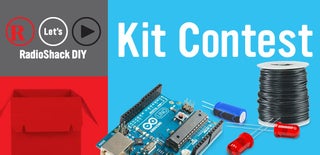Introduction: Easy Basic Arduino Ethernet Controller
I recently went out and bought an Arduino Ethernet Shield but couldnt really put it to use as i couldnt find any easy tutorials so i started to try to code by myself.I was able to come up with a simple section of code which turned on a LED from your internet broweser.Unfortunatly so far i have not been able to control the LED from outside of my home network.
Step 1: Parts
An Arduino
An Arduino Ethernet Shield
A Breadboard
An LED
Connecting Wires
An Ethernet cable
Step 2: Initial Hardware Set Up
If you have one of the newer Arduino Ethernet Shields,it will come with the Mac Address writen on the back of it.
Write that down seperatly before attaching your Shield to the Arduino Board.
To set up,just plug in the header pins from the shield into your Arduino.
Use the ethernet cable to conect your Arduino Ethernet Shield to your Network via your Router.
Note that The Ethernet shield is attached to pins 10, 11, 12, 13 so those cannot be used.
Connect the Positive end of the LED on a breadboard and in turn to Pin 8 and the negative end of the LED to Ground on the Ethernet shield.
Step 3: Acquiring the Basic Info (MAC Address,IP Address,Port Number)
If you have one of the newer Shields it should come with the Mac adress written on the back.
The IP address will be dependent on your local network and to find that out you can use Comamnd Promt.
Open up command promt and type in "ipconfig"
It should then show you your IP Address,default gateway and your subnet mask
You will also need the port you want to use.Port 80 is default for HTTP but since my internet provider had it blocked i ended up using port 8081.
Step 4:
/*
Web Server
A simple web server
Circuit:
* Ethernet shield attached to pins 10, 11, 12, 13
*/
//-------------------------------------------------------------------------------------------------------
#include <SPI.h>
#include <Ethernet.h>
// Enter a MAC address and IP address for your controller below.
byte mac[] = {0x90, 0xA2, 0xDA, 0x0D, 0x48, 0xD3 };
// The IP address will be dependent on your local network:
// assign an IP address for the controller:
IPAddress ip(192,168,1,20);
IPAddress gateway(192,168,1,1);
IPAddress subnet(255, 255, 255, 0);
// Initialize the Ethernet server library with the port you want to use.
EthernetServer server(8081);
String readString;
//-------------------------------------------------------------------------------------------------------
//-------------------------------------------------
// Any extra codes for Declaration :
// Declare Pin 8 as an LED because thats what we will be connecting the LED to.You could use any other pin and would then have to change the pin number.
int led = 8;
//-------------------------------------------------
//-------------------------------------------------------------------------------------------------------
void setup()
{
//-------------------------------------------------
// Extra Set up code:
pinMode(led, OUTPUT); //pin selected to control
//-------------------------------------------------
//-------------------------------------------------------------------------------------------------------
//enable serial data print
Serial.begin(9600);
//start Ethernet
Ethernet.begin(mac, ip, gateway, subnet);
server.begin();
Serial.print("Server is at ");
Serial.println(Ethernet.localIP());
Serial.println("LED Controller Test 1.0");
}
//-------------------------------------------------------------------------------------------------------
//-------------------------------------------------------------------------------------------------------
void loop()
{
// listen for incoming clients
EthernetClient client = server.available();
if (client)
{
Serial.println("new client");
while (client.connected())
{
if (client.available())
{
char c = client.read();
//read char by char HTTP request
if (readString.length() < 100)
{
//store characters to string
readString += c;
//Serial.print(c);
Serial.write(c);
// if you've gotten to the end of the line (received a newline
// character) and the line is blank, the http request has ended,
// so you can send a reply
//if HTTP request has ended
if (c == '\n') {
Serial.println(readString); //print to serial monitor for debuging
//--------------------------------------------------------------------------------------------------------
// Needed to Display Site:
client.println("HTTP/1.1 200 OK"); //send new page
client.println("Content-Type: text/html");
client.println();
client.println("<HTML>");
client.println("<HEAD>");
//--------------------------------------------------------------------------------------------------------
//-------------------------------------------------
// what is being Displayed :
client.println("<TITLE>Home Automation</TITLE>");
client.println("<center>");
client.println("</HEAD>");
client.println("<BODY>");
client.println("<H1>Home Automation</H1>");
client.println("<hr />");
client.println("<center>");
client.println("<a href=\"/?lighton\"\">Turn On Light</a>");
client.println("<br />");
client.println("<br />");
client.println("<a href=\"/?lightoff\"\">Turn Off Light</a><br />");
client.println("</BODY>");
client.println("</HTML>");
delay(1);
//stopping client
client.stop();
//-------------------------------------------------
// Code which needs to be Implemented:
if(readString.indexOf("?lighton") >0)//checks for on
{
digitalWrite(8, HIGH); // set pin 8 high
Serial.println("Led On");
}
else{
if(readString.indexOf("?lightoff") >0)//checks for off
{
digitalWrite(8, LOW); // set pin 8 low
Serial.println("Led Off");
}
}
//clearing string for next read
readString="";
// give the web browser time to receive the data
delay(1);
// close the connection:
client.stop();
Serial.println("client disonnected");
}
}
}
}
}
}
Step 5: Feedback
Try the steps and see if it works out if it doesnt work i will try to figure out what went wrong and do leaves comments so i can improve.

Participated in the
Remote Control Contest

Participated in the
Arduino Contest

Participated in the
Kit Contest













